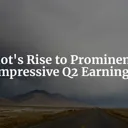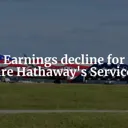Tags: Pilot / Expansion / Earnings
This fanpage is not officially affiliated with Berkshire Hathaway: Disclaimer
In 2024, Berkshire Hathaway’s full acquisition of Pilot Travel Centers [Pilot] marked a transformative “golden spike” moment—fueling a vast, modern network poised to lead America’s highway commerce. Let us have a look at how 2024 turned out for Pilot.

Introduction
In the grand narrative of American enterprise, few stories are as enduring—or as transformative—as the building of the Transcontinental Railroad. That “iron road” stitched together distant frontiers, fueled commerce, and forever altered the nation’s landscape. In 2024, Pilot Travel Centers stands as the modern equivalent: a vast, interconnected network powering the movement of goods and people across North America. Just as the railroads once did, Pilot’s travel centers now serve as the arteries of over-the-road commerce, connecting communities, supporting industries, and enabling daily journeys both great and small.
This year marks a historic milestone for both Pilot and its parent company, Berkshire Hathaway. With the final acquisition of all remaining shares in January 2024, Pilot became a wholly owned subsidiary—no longer just a strategic investment, but a fully integrated pillar of Berkshire’s empire 1. From its humble beginnings in 1958 to its current stature, Pilot has grown into a colossus of mobility infrastructure, operating nearly 900 locations across 44 U.S. states and five Canadian provinces, welcoming 1.2 million guests every day, and commanding the third largest fuel tanker fleet in North America 5. With around 29,000 employees, Pilot is one of the largest subsidiaries of Berkshire Hathaway 1.
The travel center industry itself is a landscape of consolidation and competition, dominated by a handful of major operators—such as Love’s Travel Stops and TravelCenters of America—alongside a patchwork of smaller independents 1. This mirrors the historic consolidation of the railroads, where scale, efficiency, and reach determined who would shape the future of transportation.
In this special report, we invite Berkshire Hathaway shareholders to journey through Pilot’s transformative 2024. We’ll examine the strategic ownership changes culminating in Berkshire’s “golden spike” moment, the modernization and expansion of Pilot’s network, the company’s adaptation to new energy realities, and its ongoing commitment to resilience and environmental stewardship. Through the lens of history and with an eye on the horizon, we’ll provide a panoramic, engaging, and insightful review of how Pilot is laying the track for the next era of American commerce.
Ownership: The Final Golden Spike
The completion of the Transcontinental Railroad in 1869 was immortalized by the driving of the “golden spike”—a symbolic act that connected the nation’s coasts and heralded a new age of prosperity. In much the same spirit, Berkshire Hathaway’s acquisition of the final 20% stake in Pilot Travel Centers in January 2024 represents the culmination of a multi-year journey ↗: the “golden spike” moment that brought Pilot fully into the Berkshire fold 1.
| Year | Berkshire Stake (%) | Key Event |
|---|---|---|
| 2017 | 38.6 | Initial noncontrolling interest acquired ($2.8B) |
| Jan 31, 2023 | 80.0 | Additional 41.4% acquired ($8.2B), control gained |
| Jan 16, 2024 | 100.0 | Final 20% acquired, full ownership achieved |
This staged approach was not without its drama. Echoing the rivalries and legal wrangling of 19th-century railroad tycoons, the final phase of the acquisition was accompanied by a high-profile legal dispute between Berkshire Hathaway and the Haslam family, Pilot’s founders. Allegations of improper accounting and secret payments led to lawsuits and countersuits in late 2023, capturing headlines and shareholder attention alike. Yet, in true Berkshire fashion, the matter was resolved decisively: all claims and counterclaims were dismissed in January 2024, clearing the way for a unified future 3.
Why did Berkshire pursue full ownership? The answer lies in the company’s enduring philosophy: seek out essential, “boring” businesses with durable competitive advantages, and let them thrive under hands-off, long-term stewardship. For Berkshire, Pilot’s strategic value is clear. As the backbone of North America’s highway commerce, Pilot offers vertical integration—from fuel supply to retail services—across a network that is nearly impossible to replicate at scale. Full ownership means greater operational control, streamlined decision-making, and the ability to align Pilot’s growth with Berkshire’s broader vision.
The scale of Berkshire’s commitment is equally telling: $2.8 billion for the initial 38.6% stake in 2017, followed by $8.2 billion for the next 41.4% in 2023 3. This level of investment underscores both the confidence in Pilot’s business model and the importance of its role within Berkshire’s portfolio.
From an accounting perspective, the transition from the equity method (for noncontrolling interests) to full consolidation in Berkshire’s financial statements marks a new era of transparency and accountability for shareholders 2. Pilot’s revenues, costs, and results are now fully reflected in Berkshire’s consolidated earnings, providing a clearer picture of its contribution to the parent company’s performance.
Berkshire Hathaway’s “golden spike” at Pilot was more than a financial transaction—it is a statement of intent. It signals a belief in the enduring value of infrastructure, the power of scale, and the wisdom of investing in the businesses that keep America moving. As Warren Buffett has long maintained, the best investments are those that are “essential, understandable, and built to last.” In 2024, Pilot Travel Centers fits that mold perfectly—serving as the track upon which the next generation of American commerce will run.
Network Expansion and Modernization: Laying New Track
If the transcontinental railroad was America’s original Golden Spike moment, then 2024 stands as Pilot’s own era of bold renewal and expansion—a year when Berkshire’s newest wholly-owned subsidiary laid fresh track for the journeys of millions. In a fiercely competitive travel center industry, where differentiation can be as elusive as a mirage on the interstate, Pilot’s growth strategy is rooted in tangible, guest-focused enhancements that echo the grand ambitions of the Gilded Age’s railroads: win on experience, win on service, and win on scale.
2024 was a year of physical and experiential transformation. Pilot unveiled its largest-ever flagship location in Stanton, Tennessee—a 20,000+ square foot travel center that sets a new benchmark for the network. This bold, brand-forward site features a guest-centric layout, expanded fresh food offerings, and a design that signals the future of roadside hospitality. But the Stanton flagship is just the most visible spike in a much longer line of upgrades.
Key 2024 Modernization Milestones:
- Over 200 Pilot and Flying J locations underwent significant renovations as part of the ambitious “New Horizons” initiative. These remodels are not mere facelifts: they deliver modernized restrooms and showers, expanded kitchens, and improved layouts—changes that have been shown to increase the likelihood of guest return by an impressive 80%5.
- Five new maintenance and tire service shops were opened, expanding the reach of the Southern Tire Mart partnership to over 80 locations nationwide—a critical support for professional drivers and fleets5.
- The network grew with the opening of new travel centers—including the first of 2025 in Winfield, Alabama—and the addition of three dealer locations to the Pilot and One9 network, adding 150+ truck parking spaces5.
- The EV charging network surpassed 130 locations across more than 25 states, as Pilot continues to roll out fast-charging stations under its agreement with General Motors, aiming for 2,000 chargers at 500 U.S ↗. locations by 202651.
These upgrades are not just about bricks and mortar—they are about redefining the travel center experience. In a landscape where the largest players (like Love’s and TravelCenters of America) and a multitude of independents vie for loyalty, Pilot’s investment in modern amenities, clean facilities, and guest-centric design is a direct response to the evolving expectations of both professional drivers and families on the move.
The scale of Pilot’s network is itself a competitive moat: with nearly 900 locations spanning 44 U.S. states and five Canadian provinces, Pilot serves a daily cross-section of America—1.2 million guests ranging from long-haul truckers to vacationing families5. Strategic siting near interstate highways ensures that Pilot’s centers are as vital to today’s freight and passenger flows as the great rail junctions were to the 19th-century economy1.
Digital innovation is the connective tissue that ties this network together. The myRewards Plus app offers tailored incentives—professional drivers can earn up to 5 points per gallon after six fills of 50+ gallons of diesel, while auto drivers enjoy a 10¢ discount per gallon, and all guests benefit from personalized offers like free drinks with food purchases5. This digital engagement not only drives loyalty but also enables Pilot to deliver a seamless, modern experience that meets the expectations of today’s tech-savvy travelers.
Pilot’s 2024 expansion and modernization is not just about keeping pace—it’s about setting the pace, laying new track for a future where service, scale, and technology converge to create enduring value for guests and shareholders alike.
Financial Performance: Locomotive Power
Every great railroad needs a powerful locomotive—and in 2024, Pilot’s financial engine continued to demonstrate the robust scale and operational muscle that Berkshire Hathaway values in its subsidiaries. The numbers tell a story of both resilience and recalibration as Pilot navigated a year of industry headwinds and strategic shifts.
2024 Financial Highlights:
| Metric | 2024 ($ millions) | 2023 ($ millions) |
|---|---|---|
| Revenues | 46,891 | 56,756 |
| Cost of Sales | 42,591 | 52,196 |
| Selling, General & Admin Expenses | 3,384 | 3,067 |
| Interest Expense | 302 | 437 |
| Pre-tax Earnings | 614 | 1,056 |
Revenues declined from $56.8 billion in 2023 to $46.9 billion in 2024, while pre-tax earnings fell from $1.06 billion to $614 million 2. This contraction reflects a combination of fuel price volatility, industry-wide margin pressures, and, importantly, a strategic refocusing of the business. Notably, Pilot completed its exit from the international oil trading business in 2024, choosing to channel resources into its core North American travel center operations—a move that, while reducing top-line revenue, positions the company for more stable, long-term growth 3.
Despite these headwinds, Pilot’s scale remains formidable. In 2024, the company sold approximately 11.4 billion gallons of fuel (diesel, gasoline, diesel exhaust fluid) through its company-owned, third-party, and wholesale businesses, with joint ventures adding another 900 million gallons 1. This makes Pilot one of the largest fuel retailers on the continent, operating the third largest fuel tanker fleet in North America 5.
Concentration risk and supplier diversity are carefully managed. The top 10 diesel customers accounted for about 10% of total diesel gallons sold in 2024, while the top 10 fuel suppliers represented 54% of gallons purchased1. This balance helps mitigate overreliance on any single customer or supplier, supporting both operational resilience and bargaining power.
Crucially, Pilot’s revenue base is increasingly diversified. Beyond fuel, the company generated approximately $3 billion in annual food and merchandise sales—a testament to the effectiveness of its upgraded kitchens, expanded fresh offerings, and enhanced retail environments3. This non-fuel revenue stream is vital in a world where alternative propulsion and changing travel habits threaten to erode traditional fuel margins.
The decision to exit international oil trading marks a strategic pivot. As Gary Hoogeveen, president of Pilot Energy, put it: “Pilot remains confident in our energy strategy. Our core capabilities are focused on delivering reliable fuel supply to our travel centers and wholesale customers across North America” 3. By shedding the volatility and risk of global trading, Pilot is doubling down on the steady, high-volume business of serving America’s highways—a move that aligns with Berkshire Hathaway’s preference for understandable, cash-generative operations.
Pilot’s 2024 financial performance reflects both the challenges of a dynamic market and the strength of a business built for the long haul: vast in scale, diversified in revenue, and increasingly focused on the fundamentals that drive enduring value.
Energy Transition: New Fuels on the Horizon
Just as the railroads’ shift from steam to diesel powered the next era of American commerce, Pilot’s transformation from a traditional fuel retailer to a leader in alternative energy is redefining the future of North American travel infrastructure. Under Berkshire Hathaway’s stewardship, Pilot is not only fueling journeys but also charting the course for the energy transition—a journey as consequential as the laying of the original transcontinental tracks.
Electrification is accelerating: In partnership with General Motors and EVgo, Pilot has already deployed over 130 EV fast-charging locations across more than 25 states, with a bold target of 2,000 chargers at 500 locations by 2026. These stations are strategically positioned along major corridors—routes like I-75 and the stretches from San Antonio to Houston—enabling long-distance EV travel and supporting the 1.3 million EVs sold in the U.S. in 2024, a 15% year-over-year surge 4. As Wade Sheffer, VP of GM Energy, notes, “By expanding fast-charging access along major travel routes, our work with Pilot Company and EVgo will give EV drivers more confidence to take long trips with ease” 4. This early, large-scale investment in EV infrastructure recalls the first-mover advantage of railroads racing to claim new territories—those who lay the track first, win the market for generations.
But Pilot’s energy transition is not limited to electrification. In March 2025, Pilot became the first travel center network in the country to offer B99 biodiesel for commercial fleets, launching its inaugural retail site in Decatur, Illinois, in collaboration with PepsiCo, ADM, and Optimus Technologies 6. B99 biodiesel, derived from vegetable oils, animal fats, or recycled grease, enables near-zero carbon operations for long-haul trucking. Additional B99 installations are planned for Des Moines, Iowa, and Dallas, Texas, later this year, supported by organizations such as the Iowa Soybean Association and the American Lung Association 6 ↗. As Eric Fobes, head of renewables at Pilot, affirms, “Introducing B99 at our travel centers is another way we support fleets committed to reducing carbon emissions. This collaboration... exemplifies how partnerships can create impactful solutions” 6.
Pilot’s portfolio of alternative fuels is broad and growing. The company is now one of the largest providers of biodiesel, renewable fuels, and low-carbon alternatives in North America, reflecting both regulatory imperatives and evolving customer preferences 5. The company’s water disposal business in the oil fields further diversifies its energy value chain, demonstrating a pragmatic approach to both legacy and emerging energy sectors 1.
This multi-pronged strategy positions Pilot at the forefront of a rapidly evolving regulatory and economic landscape. As governments intensify pressure for decarbonization and customers demand cleaner options, Pilot’s infrastructure-first approach—mirroring the historic railroad land rush—ensures it will capture enduring market share in the new energy era. The company’s ability to anticipate and invest ahead of the curve is not just a competitive advantage; it is the modern-day equivalent of driving the golden spike.
Resilience and Risk: Navigating Hazards
No journey—whether across the continent by rail or across the country by highway—is without its hazards ↗. In 2025, Pilot’s commitment to resilience and risk management was tested when a large fire broke out at the Flying J travel center in Anthony, Texas. The blaze, which originated in an attached Denny’s restaurant, destroyed the entire building but, thanks to swift action by employees and first responders, resulted in no injuries among the more than 20 people evacuated 7. As a company spokesperson emphasized, “The safety of our team members and guests is our top priority and we are relieved to report that all have been accounted for and are safe” 7. This incident underscores the critical importance of crisis management, emergency protocols, and community partnership in Pilot’s day-to-day operations.
With a workforce of over 29,000 employees and 1.2 million daily guests across nearly 900 locations, Pilot’s operational risk profile is as vast as the territory it serves 15. The company’s adherence to federal, state, and local environmental laws—from pollutant control to the remediation of hazardous waste sites—mirrors the regulatory rigors historically faced by railroads and utilities 1. Asset retirement obligations, such as the safe decommissioning of petroleum tanks and disposal wells, are managed with the same long-term prudence that is a hallmark of Berkshire Hathaway’s philosophy.
Risk mitigation at Pilot is both comprehensive and proactive. The company employs a multi-layered approach: robust insurance coverage, detailed emergency response protocols, supplier diversification to mitigate fuel market volatility, and rigorous environmental compliance. The decision to exit international oil trading in 2024 further reduced exposure to global market shocks, allowing Pilot to focus on its core North American operations and reinforcing its resilience amid unpredictable energy markets 3. As Gary Hoogeveen, president of Pilot Energy, stated, “Pilot remains confident in our energy strategy. Our core capabilities are focused on delivering reliable fuel supply to our travel centers and wholesale customers across North America” 3.
The competitive landscape remains intense, with a handful of large operators and a constellation of nimble independents vying for market share 1. In this environment, resilience is not just about withstanding shocks, but about leveraging Berkshire Hathaway’s strengths: decentralized management, strong balance sheets, and a long-term orientation that prioritizes safety, compliance, and sustainable growth.
Like the great railroads that weathered storms, fires, and financial panics, Pilot’s ability to navigate hazards and emerge stronger is a testament to its operational discipline and enduring commitment to the communities it serves. In the new golden spike era, resilience is not just a defensive posture—it is a source of enduring competitive advantage.
Conclusion: Full Steam Ahead
The year 2024 stands as a transformative milestone in the journey of Pilot Travel Centers—a year when the company’s “track” was not only fully laid under Berkshire Hathaway’s ownership but also modernized, diversified, and strategically positioned for the future. With the final acquisition of the remaining shares, Berkshire has driven its own “golden spike,” completing a multi-year integration that elevates Pilot from a strategic investment to a core pillar of America’s economic infrastructure13. This moment marks the beginning of a new era, one where tradition and innovation converge to power the highways and byways of North America.
Pilot today embodies a unique blend of legacy and forward-thinking vision. From fueling the diesel rigs that haul freight across the continent to pioneering the rollout of EV fast-charging stations and B99 biodiesel for commercial fleets, Pilot is simultaneously a steward of a time-honored business and a harbinger of the energy transition46. This duality is rare and powerful: a company rooted in the essential, “boring” fundamentals Warren Buffett champions, yet agile and proactive in adapting to the shifting currents of technology, regulation, and consumer expectations.
Within Berkshire Hathaway’s portfolio, Pilot fits seamlessly as a dependable, cash-generative enterprise that delivers essential services to millions daily. Its vast network of nearly 900 locations, extensive fuel supply chain, and growing non-fuel revenue streams provide a durable competitive moat that mirrors the enduring value of the great railroads—those backbone businesses that shaped the American economy for generations15. Just as the railroads once connected distant frontiers and catalyzed commerce, Pilot now connects communities and industries across an evolving transportation landscape.
Looking ahead, confidence is well placed in Pilot’s ability to navigate disruption and regulatory change while meeting the evolving needs of drivers, fleets, and travelers. The company’s proactive investments in infrastructure, digital engagement, and alternative fuels demonstrate a clear-eyed understanding of the challenges and opportunities ahead56. Its resilience—tested by operational hazards and market volatility—is buttressed by Berkshire’s decentralized management philosophy, financial strength, and long-term orientation7.
For shareholders, Pilot should be seen not merely as a travel center operator but as a dynamic, resilient, and indispensable component of Berkshire’s future growth. It is a company laying the groundwork for the next century of American commerce, much like the railroads of old—building the “iron road” of the 21st century with equal parts grit, vision, and steady stewardship.
With the “track” now fully laid and the golden spike driven home, Berkshire Hathaway and Pilot Travel Centers are poised for the next great journey, ready to power forward regardless of the economic winds that lie ahead. The road is long, the challenges real, but the foundation is strong—and the destination promises enduring value for shareholders and communities alike.
References
-
Annual Report 2024 - Pilot Travel Centers - www.berkshirehathaway.com ↩↩↩↩↩↩↩↩↩↩↩↩↩↩↩
-
Annual Report 2024 - Results of Operations - Pilot Travel Centers - www.berkshirehathaway.com ↩↩
-
Pilot Co. Closes Oil Trading Business to Focus on Travel Centers - www.cspdailynews.com ↩↩↩↩↩↩↩↩↩
-
Pilot, General Motors and EVgo Connect National Travel Corridors with EV Charging Infrastructure Installed in Over 25 States - pilotflyingj.com ↩↩↩
-
Pilot Fuels the Journey with Network Enhancements in the First Quarter - pilotflyingj.com ↩↩↩↩↩↩↩↩↩↩↩↩
-
Pilot Becomes First Travel Center Network to Offer B99 Biodiesel for Fleets - www.businesswire.com ↩↩↩↩↩
-
Large fire breaks out at Anthony truck stop - www.ktsm.com ↩↩↩












